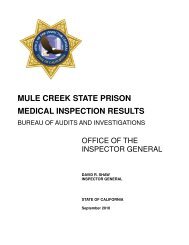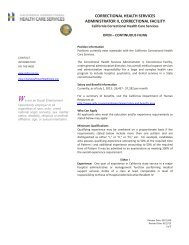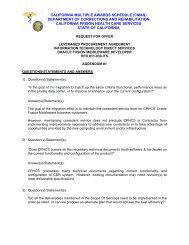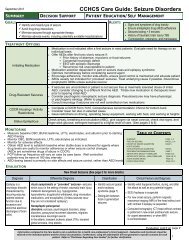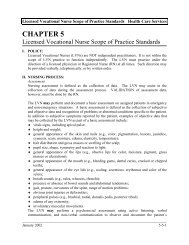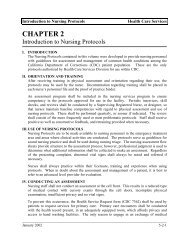Ch. 18, Physician Orders for Life Sustaining Treatment Policy
Ch. 18, Physician Orders for Life Sustaining Treatment Policy
Ch. 18, Physician Orders for Life Sustaining Treatment Policy
- No tags were found...
You also want an ePaper? Increase the reach of your titles
YUMPU automatically turns print PDFs into web optimized ePapers that Google loves.
CALIFORNIA PRISON HEALTH CARE SERVICESVOLUME 1: GOVERNANCE & ADMINISTRATIONEffective Date: 9/1/10CHAPTER <strong>18</strong>Revision Date(s):PHYSICIAN ORDERS FOR LIFE SUSTAINING TREATMENT(POLST) POLICYAttachments: Yes NoI. PURPOSEThis policy introduces the <strong>Physician</strong> <strong>Orders</strong> <strong>for</strong> <strong>Life</strong> <strong>Sustaining</strong> <strong>Treatment</strong> (POLST) Form7465 and complements the Cali<strong>for</strong>nia Department of Corrections and Rehabilitation (CDCR)Advance Directive <strong>for</strong> Health Care Form 7421. (See IMSP P&P Volume 1, <strong>Ch</strong>apter 17A and17B Advance Directive <strong>for</strong> Health Care.)II. BACKGROUNDPOLST is a legally recognized mechanism by which patients can provide specific instructions<strong>for</strong> their end-of-life care, including “requests regarding resuscitation.” It is appropriate toconsider POLST <strong>for</strong> patient-inmates that are elderly, frail, have serious medical or surgicalconditions, or who have less than six months life expectancy. Key provisions are as follows:• The <strong>for</strong>m is required to be signed by a physician and the individual or the individual’srepresentative. Health care staff may discuss the <strong>for</strong>m with the patient-inmate and helpprepare the <strong>for</strong>m but the POLST must be signed by a physician.• Requires that health care providers honor POLST orders.• Provides immunity 1 <strong>for</strong> honoring a POLST <strong>for</strong>m that appears valid.III. DEFINITIONSAdvance Directive <strong>for</strong> Health Care: Allows the patient-inmate to do either or both of thefollowing: 1) state instructions <strong>for</strong> future health care decisions; and/or 2) appoint an agent withPower of Attorney <strong>for</strong> Health Care. (See CDCR Form 7421, Advanced Directive <strong>for</strong> HealthCare)Do Not Resuscitate (DNR): A written order which directs that resuscitation ef<strong>for</strong>ts(i.e., intubation and assisted mechanical ventilation, cardiac compression, defibrillation, andadministration of cardiotonic drugs) are not to be initiated in the event of cardiac and/orrespiratory arrest.<strong>Physician</strong> <strong>Orders</strong> <strong>for</strong> <strong>Life</strong>-<strong>Sustaining</strong> <strong>Treatment</strong> (POLST): A physician order thatdocuments a patient-inmate’s ‘preferred intensity of care’ concerning life-sustaining treatmentand end of life care, including resuscitation status, and which translates those expressedpreferences into a physician’s order. (See CDCR Form 7465, <strong>Physician</strong> <strong>Orders</strong> <strong>for</strong> <strong>Life</strong><strong>Sustaining</strong> <strong>Treatment</strong>)Representative: The patient-inmate’s legally recognized health care decision maker.IV. POLICYA. General Direction1. Patient-inmates have a fundamental right to make their own health care decisions,including treatment decisions regarding medications, surgeries, and life-supporttreatments (Cal. Probate Code § 4650; DOM <strong>Ch</strong>apter. 9, Art. 10 § 91100).1 Provides statutory immunity from criminal prosecution, civil liability, discipline <strong>for</strong> unprofessional conduct,administrative sanction or any other sanction to a healthcare provider who relies in good faith on the request andhonors it.September 2010 Volume 1, <strong>Ch</strong>apter <strong>18</strong> Page 1 of 4POLICY
CALIFORNIA PRISON HEALTH CARE SERVICES2. The CDCR POLST Form 7465 covered in this policy and Form 7421, AdvanceDirective <strong>for</strong> Health Care, covered in the Advance Directive <strong>for</strong> Health Care policy, arethe preferred methods <strong>for</strong> CDCR patient-inmates to communicate their end of lifewishes and intensity of care. Other documentation of end of life preferences providedby patient-inmates or their surrogates will be honored. However, ef<strong>for</strong>ts should bemade to document the patient-inmate’s requests on the POLST Form.3. Patient-inmates or their representative may initiate or revoke a POLST at any time. If apatient-inmate is unable to sign a POLST, the provider must document and honor theverbal instructions. A <strong>for</strong>mal POLST should be completed as soon possible.4. Patient-inmates may have completed an Advance Directive <strong>for</strong> Health Care prior tocompleting a POLST but this is not required.5. Patient-inmates are never required to complete a POLST or DNR. Their care is notconditional on the completion of a POLST or DNR.B. Completing the POLST Form1. CPHCS encourages staff to promote patient-inmate’s use of the POLST <strong>for</strong>m wheneverit is appropriate.2. Health care staff has professional obligations to discuss end of life decision-making andgoals of care, as well as patient-inmates’ right to name a health care agent and tospecify their end of life preferences. This discussion should occur at clinicallyappropriate times with patient-inmates who are elderly, frail, have serious medical orsurgical conditions, or who have less than six months life expectancy. The provider isresponsible <strong>for</strong> using language and communication methods that are appropriate andeffective <strong>for</strong> the specific patient-inmate. It is often a good practice <strong>for</strong> providers toengage their patients in end of life preference discussions as soon as patient-inmatesmeet those criteria.3. Primary Care Providers (PCP) must document in the UHR all discussions with apatient-inmate regarding the POLST Form. The <strong>Ch</strong>ief <strong>Physician</strong> Executive shall issuesupport material to accompany the POLST order <strong>for</strong>m that includes guidance regardingthe completion and documentation.4. The treating provider shall be responsible <strong>for</strong> determining whether a patient-inmate oragent or decision maker is capable of making health care decisions. The provider shallrequest a psychiatric consultation or obtain the assistance of the <strong>Ch</strong>ief MedicalExecutive / <strong>Ch</strong>ief Medical Officer (CME/CMO) when there is a question concerning aninmate’s capacity to make health care decisions. Determination of diminished capacityshall be documented in the Unit Health Record (UHR).5. The PCP shall seek the concurrence and consent of the patient-inmate, agent orsurrogate decision-maker be<strong>for</strong>e completing a POLST <strong>for</strong>m. In the event the patientinmateis unable to communicate in<strong>for</strong>med health care decisions or lacks the capacity tomake health care decisions, and has not designated a surrogate decision-maker eitherorally or via a written Advance Directive <strong>for</strong> Health Care, the treating provider, CME /CMO, and Regional Medical Executive (RME) shall work with the CPHCS LegalAffairs to identify appropriate steps to obtain legal authority <strong>for</strong> appointment of asurrogate decision-maker.C. Distribution and Filing1. Blank POLST <strong>for</strong>ms and guidance material <strong>for</strong> staff must be available in all health caresettings.September 2010 Volume 1, <strong>Ch</strong>apter <strong>18</strong> Page 2 of 4POLICY
CALIFORNIA PRISON HEALTH CARE SERVICES2. A copy of this policy must be available in the Institution Law Library.3. The current original unrevoked POLST is filed on top of the <strong>Physician</strong> Order’s section<strong>for</strong> outpatient health records and, if in an inpatient setting a copy of the currentunrevoked POLST is filed on top of the <strong>Physician</strong> Order’s section in the inpatienthealth record. The POLST <strong>for</strong>m is double sided and both sides must be copied.4. Any revoked POLST original or copy shall be lined out and marked “revoked-void”and filed in the <strong>Physician</strong>’s Order section in the outpatient chart and, if in an inpatientsetting, also in the inpatient health records.5. Health In<strong>for</strong>mation Management (HIM) staff shall apply a bright orange 1 X 3 label onthe outside cover of the inpatient and outpatient health record directly adjacent to the“Allergic to” area, noting that an inmate has a POLST. The label (Advance Directive /POLST Alert Label) shall state in bold letters, “POLST in place” with a completedcheckbox.6. A copy of the POLST <strong>for</strong>m shall accompany the patient-inmate on trips to the hospital<strong>for</strong> admissions and when transferred to other health care facilities.D. Conflict Resolution and Special Situations1. In the event a patient-inmate requests medical treatment contrary to generally acceptedmedical standards, or if the requested medical care would be medically ineffective, or<strong>for</strong> reasons of conscience, the health care provider or institution (<strong>for</strong> institutions theremust be a pre-existing institutional policy) may decline to comply with the preferencesof the patient-inmate or the patient-inmate’s agent or surrogate.2. If the patient-inmate requests “Do Not Attempt Resuscitation” status on A of thePOLST it is understood that every ef<strong>for</strong>t shall be made to relieve the patient-inmate’ssuffering and maintain com<strong>for</strong>t. Specifically, a “Do Not Attempt Resuscitation”order does not imply that other therapeutic measures necessary to promotecom<strong>for</strong>t will be withheld (e.g., palliative treatment <strong>for</strong> pain, dyspnea, majorhemorrhage, or other medical conditions).3. Terms such as “slow code” and “chemical code” are inappropriate and shall not beused. In the absence of a POLST order specifying “Do Not Attempt Resuscitation” fullCardio Pulmonary Resuscitation shall be initiated <strong>for</strong> any patient-inmate experiencingcardiac and/or respiratory arrest, unless otherwise indicated.4. If there is suspicion that a patient-inmate’s cardiorespiratory arrest is not a part of anatural or expected death then resuscitation shall be attempted despite the presence of aPOLST stating no attempt at resuscitation. This would include a patient-inmatesuspected of attempted suicide or possibly suffering harm by another.5. The treating provider shall be responsible <strong>for</strong> discussing with the patient and/orsurrogate as appropriate and documenting in the UHR whether the POLST/DNR ordersare to be maintained or suspended during anesthesia and surgery. This decision shall becommunicated to the surgeon prior to the date of the procedure by the treating provider.If the surgeon refuses to honor the patient’s wishes a referral to another surgeon willingto do so should be generated by the provider and the CME/CMO should be notified.The surgical team and the patient determine in advance of the procedure specificallywhen the POLST/DNR orders are to be suspended and reinstated.September 2010 Volume 1, <strong>Ch</strong>apter <strong>18</strong> Page 3 of 4POLICY
CALIFORNIA PRISON HEALTH CARE SERVICESE. Honoring POLST <strong>Orders</strong> Completed Outside of the Institution1. If a patient-inmate with a completed POLST transfers to or from another CDCRinstitution or outside healthcare facility, the receiving institution/facility must acceptthe sending institution’s POLST orders.F. Documenting the Code Status of a Critically Ill Patient-Inmate Who Has No POLSTor Advance Directive1. Completion of a POLST <strong>for</strong>m is not always possible. If DNR status is clinicallyindicated and in keeping with the patient-inmates wishes, providers may write DNRorders in the absence of a POLST <strong>for</strong>m.2. For DNR orders without an accompanying POLST <strong>for</strong>m, a supervising physician notdirectly involved in the care of the patient-inmate shall document his/her concordancein the medical record.3. A DNR order written without a POLST means only that the patient-inmate is not toreceive resuscitative measures in the event of a full arrest. Any other limits on medicalinterventions, such as “do not intubate” or “no blood products,” must be specificallyordered.V. RESPONSIBILITIESThe CME/CMO, <strong>Ch</strong>ief Executive Officer/Health Care Manager (CEO/HCM), and <strong>Ch</strong>ief NurseExecutive/Director of Nurses (CNE/DON) at each institution are responsible <strong>for</strong>implementation of this policy.VI. RELATIONSHIP TO OTHER POLICIESIMSP&P Volume 1, <strong>Ch</strong>apter 17A and 17B Advance Directive <strong>for</strong> Health Care governs thepatient-inmate’s right to make decisions regarding their health care and appoints an agent tomake decisions <strong>for</strong> them. That procedure includes labeling the presence of a POLST in theUHR and problem list. The definitions in the IMSP&P Advance Directive <strong>for</strong> Health Care alsoapply to this policy.VII. REFERENCES• Cal. Probate Code §4650, 4780, 4780c, 4781, 4781.2, 4781.5, 4782, 4783, 4785, 4609,4654, 4734, 4735• DOM <strong>Ch</strong>apter. 9, Art. 10, § 91100, 91100.1, 91100.4.1, 91100.4.3, 91100.5, 91100.6,91100.8 and 91100.10, 91100.13• POLST <strong>for</strong>m approved by the Emergency Medical Services Authority can be accessed at:www.finalchoices.org/polst-<strong>for</strong>mSeptember 2010 Volume 1, <strong>Ch</strong>apter <strong>18</strong> Page 4 of 4POLICY



